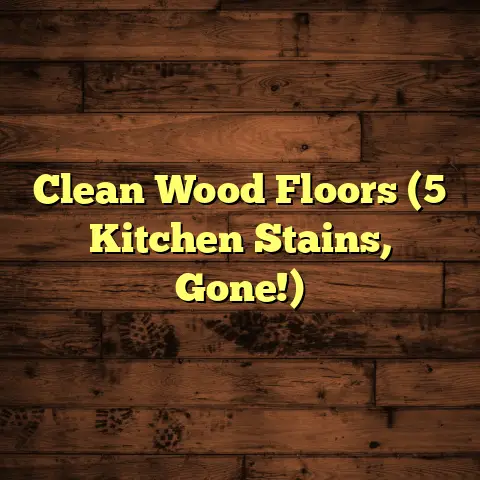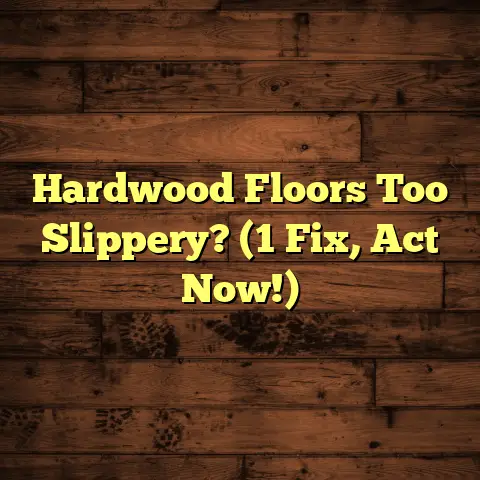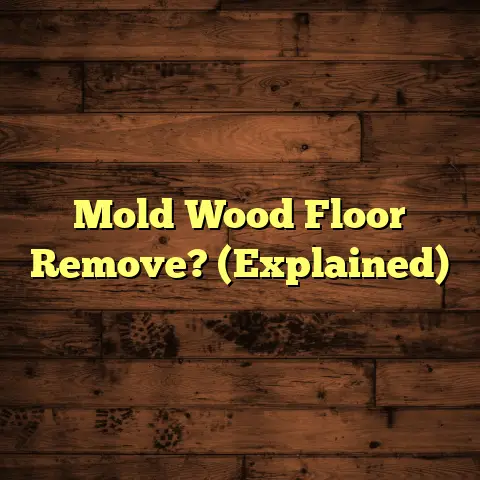Floor Mats For Total Gym? (9 To Prevent Cracks!)
Did you know that the right floor mat could not only enhance your workout experience but also save you thousands in flooring repairs?
As a flooring contractor for over 15 years, I’ve seen firsthand the carnage gym equipment can inflict on unsuspecting floors.We’re talking cracks, dents, and even full-blown structural damage.
Your home gym should be a sanctuary, not a source of anxiety.
And that starts from the ground up – literally!
The unsung hero of any home gym is the humble floor mat.
I’m here to tell you why flooring matters more than you think, especially when you’re rocking a Total Gym.
This versatile piece of equipment is a favorite for many, but its weight and movement can wreak havoc on your floors if you’re not careful.
I’m going to walk you through everything you need to know about choosing the right floor mats for your Total Gym.
We’ll cover the different types available, key features to look for, how to install them, and even real-life examples of how they’ve saved homeowners from costly repairs.
So, let’s dive in and protect that precious flooring!
Section 1: Understanding the Impact of Gym Equipment on Flooring
Let’s talk about what’s under your feet.
Is it beautiful hardwood, sleek tile, cozy carpet, or something else?
Each of these flooring types reacts differently to the stresses of gym equipment.
Hardwood, while gorgeous, can be susceptible to scratches, dents, and even cracking under the concentrated weight of a Total Gym.
Tile, especially ceramic or porcelain, can crack under heavy impact.
Carpet, while providing some cushioning, can be easily compressed and stained, and it doesn’t offer much protection against heavier equipment.
Think about it: when you’re using your Total Gym, you’re not just dealing with the weight of the machine itself.
You’re adding your own body weight, plus the force of your movements.
All of that energy gets transferred to the floor, creating stress points that can lead to damage over time.
Vibration is another sneaky culprit.
Even seemingly small vibrations from your workouts can loosen tiles, weaken hardwood joints, and compress carpet fibers.
“According to a study by the American Society of Civil Engineers, vibrations from household activities can contribute to structural fatigue in buildings over time.”
I’ve personally seen countless cases where homeowners have underestimated the impact of their gym equipment on their flooring.
One client of mine had beautiful hardwood floors that were completely destroyed after just a few months of using a weight bench without proper protection.
The repair bill was over $5,000!
Don’t let that happen to you.
Section 2: The Benefits of Using Floor Mats
So, why are floor mats so essential?
Well, they offer a whole host of benefits beyond just protecting your flooring.
First and foremost, they provide a crucial layer of protection between your equipment and the floor.
This helps to distribute weight, absorb impact, and prevent scratches, dents, and cracks.
Floor mats also enhance stability.
A good mat will provide a non-slip surface, preventing your Total Gym from sliding around during your workouts.
This is especially important for exercises that involve a lot of movement or dynamic motion.
Another benefit that often gets overlooked is noise reduction.
Gym equipment can be noisy, especially if you live in an apartment or have family members who are sensitive to sound.
Floor mats can help to dampen vibrations and reduce noise levels, creating a more peaceful workout environment.
And let’s not forget about safety.
Floor mats can provide a cushioned surface that helps to reduce the risk of injuries from falls or slips.
This is particularly important if you’re doing high-impact exercises or working with heavy weights.
I’ve heard from many fitness enthusiasts who swear by floor mats.
One client told me that since investing in floor mats, she feels more confident and stable during her workouts.
She also appreciates the peace of mind knowing that her floors are protected.
“I used to worry about scratching my hardwood floors,” she said.
“But now I can focus on my workout without any distractions.”
And of course, there’s the potential cost savings.
By preventing floor damage, you can avoid expensive repairs and maintenance down the road.
Think of floor mats as an investment in the long-term health of your home.
Section 3: Types of Floor Mats Suitable for Total Gym
Alright, let’s get into the nitty-gritty of different floor mat types.
There’s a whole world of options out there, each with its own pros and cons.
Let’s explore some of the most popular choices for your Total Gym setup.
1. Rubber Mats:
These are the heavy-duty champions of the floor mat world.
Rubber mats are known for their incredible durability and shock absorption.
They can withstand heavy weight and repeated impact without showing signs of wear and tear.
Pros:
- Extremely durable and long-lasting.
- Excellent shock absorption.
- Provides a stable, non-slip surface.
- Resistant to water and sweat.
Cons:
- Can be heavy and difficult to move.
- May have a rubbery odor initially.
- Can be more expensive than other options.
Ideal Usage:
Rubber mats are perfect if you’re serious about protecting your floors and need something that can handle heavy use.
They’re ideal for dedicated home gyms where the equipment is unlikely to be moved frequently.
2. Foam Mats:
Foam mats are a more lightweight and affordable option.
They’re typically made from EVA foam, which is soft, cushioning, and easy to work with.
Pros:
- Lightweight and easy to install.
- Good for noise reduction.
- Affordable and widely available.
- Provides some cushioning for comfort.
Cons:
- Less durable than rubber mats.
- Can be easily punctured or torn.
- May not provide enough protection for very heavy equipment.
Ideal Usage:
Foam mats are a good choice if you’re on a budget or need something that’s easy to move and store.
They’re suitable for lighter workouts and can be a good option for protecting floors from scratches and minor impacts.
3. Interlocking Tiles:
These are like the LEGOs of the floor mat world.
Interlocking tiles come in individual pieces that can be connected to create a custom-sized mat.
Pros:
- Customizable and easy to adjust.
- Easy to replace individual tiles if damaged.
- Versatile and can be used in various configurations.
- Often come in different colors and patterns.
Cons:
- Can be more expensive than other options.
- May not be as durable as rubber mats.
- Can sometimes come apart during intense workouts.
Ideal Usage:
Interlocking tiles are a great choice if you need a mat that can be easily customized to fit your space.
They’re also a good option if you want to be able to replace individual tiles if they get damaged.
4. Vinyl Mats:
Vinyl mats are known for their durability and easy-to-clean surface.
They’re resistant to water, sweat, and stains, making them a good option for sweaty workouts.
Pros:
- Easy to clean and maintain.
- Resistant to water and sweat.
- Durable and long-lasting.
- Provides a smooth, non-slip surface.
Cons:
- Can be more expensive than foam mats.
- May not provide as much cushioning as rubber mats.
- Can be slippery when wet.
Ideal Usage:
Vinyl mats are a good choice if you’re looking for something that’s easy to clean and can withstand heavy use.
They’re ideal for home gyms where hygiene is a top priority.
5. Carpet Tiles:
If you want a more comfortable and aesthetically pleasing option, carpet tiles might be a good choice.
They provide a soft, cushioned surface that’s comfortable underfoot.
Pros:
- Comfortable and warm underfoot.
- Available in various designs and colors.
- Provides some sound absorption.
- Easy to install and replace.
Cons:
- Can be difficult to clean.
- Not as durable as other options.
- May not provide enough protection for heavy equipment.
Ideal Usage:
Carpet tiles are a good choice if you want a more comfortable and inviting workout space.
They’re suitable for lighter workouts and can be a good option for protecting floors from scratches and minor impacts.
Ultimately, the best type of floor mat for your Total Gym will depend on your individual needs and preferences.
Consider your budget, the type of flooring you have, the intensity of your workouts, and your aesthetic preferences when making your decision.
Section 4: Key Features to Look for in Floor Mats
Now that you know the different types of floor mats available, let’s talk about the key features you should be looking for when making your selection.
Thickness:
Thickness is a crucial factor to consider, as it directly affects the mat’s ability to absorb impact and protect your floors.
A thicker mat will generally provide better protection, especially for heavier equipment and high-impact exercises.
I generally recommend a thickness of at least 3/8 inch for most home gym applications.
If you’re using very heavy equipment or doing a lot of high-impact exercises, you may want to consider a mat that’s 1/2 inch or thicker.
Material:
As we discussed earlier, different materials offer different benefits.
Rubber is the most durable and shock-absorbent option, while foam is more lightweight and affordable.
Vinyl is easy to clean, and carpet tiles offer a more comfortable surface.
Consider your priorities when choosing a material.
Do you need maximum protection?
Or are you more concerned about comfort and aesthetics?
Size and Coverage:
Make sure to measure the area where you’ll be using your Total Gym and choose a mat that provides adequate coverage.
You want to ensure that the entire footprint of the equipment is covered, with some extra space around the edges.
This will help to protect your floors from scratches and dents, even if the equipment shifts slightly during your workouts.
Slip Resistance:
Slip resistance is essential for safety.
You want to choose a mat that provides good traction, even when wet.
Look for mats with a textured surface or a non-slip backing.
This will help to prevent slips and falls during your workouts.
Ease of Cleaning and Maintenance:
Let’s face it: workouts can be sweaty.
You’ll want to choose a mat that’s easy to clean and maintain.
Rubber and vinyl mats are generally the easiest to clean, as they’re resistant to water and sweat.
Foam mats can be cleaned with a damp cloth, but they may be more difficult to remove stains from.
Carpet tiles can be vacuumed, but they may require professional cleaning to remove stubborn stains.
Here’s a handy table to summarize the key features:
| Feature | Rubber Mats | Foam Mats | Interlocking Tiles | Vinyl Mats | Carpet Tiles |
|---|---|---|---|---|---|
| Thickness | High (3/8″ – 1/2″+) | Medium (1/4″ – 3/8″) | Medium (3/8″ – 1/2″) | Medium (1/4″ – 3/8″) | Low (1/4″ – 1/2″) |
| Material | Recycled/Virgin Rubber | EVA Foam | EVA Foam/Rubber Blend | PVC/Vinyl | Carpet Fiber/Foam Backing |
| Size/Coverage | Various, Large Rolls | Customizable, Smaller | Customizable, Modular | Various, Rolls/Sheets | Modular, Smaller |
| Slip Res. | Excellent | Good | Good | Good | Moderate |
| Clean/Maint. | Easy, Wipe Down | Easy, Wipe Down | Easy, Wipe Down | Very Easy, Wipe Down | Moderate, Vacuum |
Section 5: Installation and Maintenance of Floor Mats
Alright, you’ve chosen your floor mats. Now, let’s get them installed!
Here’s a step-by-step guide to help you get the job done right:
Step 1: Prepare the Area:
Clear the area where you’ll be installing the mats.
Remove any furniture, equipment, or debris.
Sweep or vacuum the floor to ensure it’s clean and free of dust.
Step 2: Measure and Cut (if necessary):
If you’re using interlocking tiles, you may need to cut some of the tiles to fit your space.
Use a utility knife or a sharp pair of scissors to make clean cuts.
If you’re using a roll of rubber or vinyl, measure the area and cut the mat to the appropriate size.
Step 3: Lay Out the Mats:
Start by laying out the mats in the center of the area.
If you’re using interlocking tiles, connect the tiles together as you go.
Make sure the mats are aligned properly and that there are no gaps between them.
Step 4: Secure the Mats (if necessary):
Depending on the type of mat you’re using, you may need to secure it to the floor.
Rubber and vinyl mats can be secured with double-sided tape or adhesive.
Interlocking tiles usually stay in place on their own, but you can use tape to secure the edges if desired.
Common Mistakes to Avoid:
- Not cleaning the floor before installation: This can prevent the mats from adhering properly.
- Not measuring properly: This can result in mats that are too small or too large for your space.
- Using the wrong adhesive: This can damage your floors or make it difficult to remove the mats later.
- Not allowing the mats to acclimate: If you’re using rubber mats, allow them to sit in the room for a few days before installing them. This will help to reduce any rubbery odor.
Tips for Maintaining Your Floor Mats:
- Clean regularly: Wipe down your mats with a damp cloth or mop after each workout.
- Use a mild detergent: For stubborn stains, use a mild detergent or cleaning solution.
- Avoid harsh chemicals: Harsh chemicals can damage the mats.
- Protect from sunlight: Prolonged exposure to sunlight can cause the mats to fade or crack.
- Replace damaged mats: If a mat becomes damaged, replace it immediately to prevent further damage to your floors.
Repositioning Mats:
As your workouts evolve or you add new equipment, you may need to reposition your floor mats.
This is generally easy to do, especially with interlocking tiles.
Simply disconnect the tiles and rearrange them as needed.
If you’re using a roll of rubber or vinyl, you may need to cut it to a different size or shape.
Section 6: Real-Life Examples and Case Studies
I always tell my clients that the best way to understand the value of floor mats is to see them in action.
So, let me share a few real-life examples of how floor mats have saved homeowners from flooring disasters:
Case Study 1: The Hardwood Hero
John, a 45-year-old accountant, invested in a Total Gym to stay in shape at home.
He had beautiful hardwood floors throughout his house and was initially hesitant to put gym equipment on them.
I recommended he use thick rubber mats to protect his floors.
He installed the mats under his Total Gym and has been using them for over two years.
“The mats have been a lifesaver,” John told me.
“I haven’t had a single scratch or dent on my hardwood floors.
I’m so glad I invested in them.”
Case Study 2: The Tile Triumph
Sarah, a 32-year-old teacher, had a small home gym with tile flooring.
She was worried about cracking the tiles with her weight bench and dumbbells.
I suggested she use interlocking foam tiles to provide cushioning and protection.
She installed the tiles and has been using them for over a year.
“The tiles have been great,” Sarah said.
“They’re comfortable to work out on, and I haven’t had any problems with cracked tiles.”
Case Study 3: The Carpet Champion
Mike, a 50-year-old retiree, had a carpeted basement that he wanted to turn into a home gym.
He was concerned about compressing the carpet fibers with his treadmill and elliptical machine.
I recommended he use carpet tiles to protect his carpet and provide a more stable surface.
He installed the tiles and has been using them for over six months.
“The tiles have made a big difference,” Mike said.
“My carpet looks much better, and I feel more stable when I’m working out.”
These are just a few examples of how floor mats can protect your flooring and enhance your workout experience.
By investing in quality floor mats, you can avoid costly repairs and enjoy your home gym for years to come.
Conclusion
So, there you have it.
Everything you need to know about choosing the right floor mats for your Total Gym.
We’ve covered the importance of flooring protection, the different types of mats available, key features to look for, installation and maintenance tips, and real-life examples of how mats have saved homeowners from flooring disasters.
Remember, investing in quality floor mats is an investment in the long-term health of your home.
By protecting your floors from damage, you can avoid costly repairs and enjoy your home gym for years to come.
So, take a look at your own gym setup.
Are your floors adequately protected?
If not, I encourage you to consider adding floor mats.
It’s a small investment that can make a big difference.
Happy workouts!





